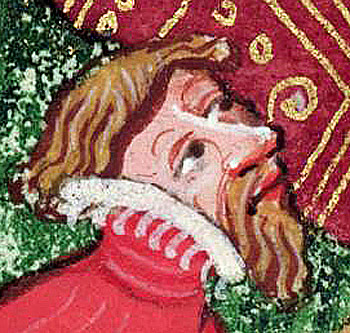Cheuelere Assigne
General Information
Plot Summary

King Oriens of Lyon and his wife Beatrice have no heir. When they see a poor woman with twins Oriens expresses pity, but Beatrice condemns the woman for adultery. Nine months later, she gives birth to six sons and a daughter, all wearing silver necklaces. Oriens’ wicked mother Matabryne secretly instructs her servant to drown the children. She replaces them with puppies and, accusing Beatrice of adultery and bestiality, demands that she be burned. The queen is thrown into prison.
Matabryne’s servant cannot bring himself to kill the infants and leaves them in the forest. They are found by a hermit, who raises them with the help of a hind that lets them suckle her milk. Eleven years later Malkadras, a forester, tells Matabryne that her grandchildren are still alive: she is furious and commands him to bring her their silver chains. He finds six of the children but as soon as he cuts off their necklaces they turn into swans. He takes the chains to Matabryne who orders a goldsmith to make them into a cup. When half a chain miraculously yields enough silver, however, the smith and his wife realise that they were wrongly acquired: they return the broken half to Matabryne and keep the others. Believing the children to be dead, the old queen exults and arranges Beatrice’s execution.
The night before it takes place, the hermit is visited by an angel who reveals that the children belong to the queen and were a punishment for her unkind words. He also informs the hermit that the six missing children have become swans: the seventh child must be christened Enyas and taken to court, where he will fight for his mother.
Although the child does not know what a ‘mother’ is, or anything about combat, he and the hermit set off. With an angel on his shoulder to guide him, Enyas confronts Oriens, telling him that Matabryne is in league with the devil. Despite his youth, the king accepts Enyas’ offer to fight for Beatrice against Malkadras, who is Matabryne’s champion. An abbot christens Enyas and Oriens knights him, giving him a horse, armour, shield and lance. After a knight has explained these items and taught him how to joust, he and Malkadras fight. Enyas’ horse blinds that of his opponent, and when Malkadras insults the cross on his shield, it miraculously emits an adder which bites him and a fire which blinds him. Enyas beheads his enemy and when Matabryne tries to flee, has her captured and burned on Beatrice’s pyre. He then reveals that he is Oriens’ son, and explains the fate of the other children. The goldsmith produces the five remaining chains which, as soon as they are placed on the necks of the swans, return them to human form. The one swan left without a chain mourns, plucking at its chest with its beak until it bleeds. Unable to look at the tragic scene, the crowd returns to the court, where the other children are christened.
From: Diane Speed. Medieval English Romances. Third Edition. Durham, Durham Medieval Texts 8, 1993.
Manuscript: London, British Library, MS Cotton Caligula Aii
Manuscripts
Click a title below to search for all romances in that manuscript.